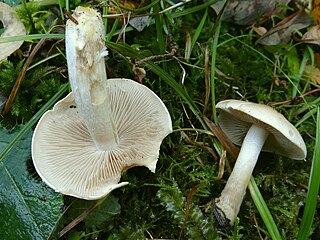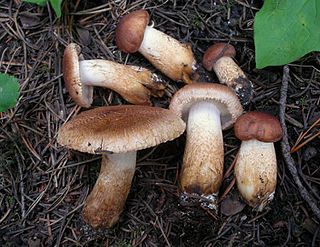
Tricholoma is a genus of fungus that contains many fairly fleshy white-spored gilled mushrooms which are found worldwide generally growing in woodlands. These are ectomycorrhizal fungi, existing in a symbiotic relationship with various species of coniferous or broad-leaved trees. The generic name derives from Ancient Greek: τριχο-, romanized: tricho-, lit. 'hair' and Ancient Greek: λῶμα, romanized: loma, lit. 'fringe, border' although only a few species have shaggy caps which fit this description.

Tricholoma pardinum, commonly known as spotted tricholoma, tiger tricholoma, tigertop, leopard knight, or dirty trich, is a gilled mushroom widely distributed across North America, Europe, and parts of Asia. It is generally found in beech woodland in summer and autumn. Two subspecies have been described from southern Europe. First officially described by Christiaan Hendrik Persoon in 1801, T. pardinum has had a confusing taxonomic history that extends over two centuries. In 1762, German naturalist Jacob Christian Schäffer described the species Agaricus tigrinus with an illustration corresponding to what is thought to be T. pardinum, and consequently, the name Tricholoma tigrinum has been used erroneously in some European field guides.

Melanoleuca is a poorly known genus of saprotrophic mushrooms traditionally classified in the family Tricholomataceae. Most are small to medium sized, white, brown, ocher or gray with a cylindrical to subcylindrical stipe and white to pale yellowish gills. The basidiospores are ellipsoid and ornamented with amyloid warts. Melanoleuca is considered a difficult group to study due to their macroscopic similarities among species and the need of a thorough microscopic analysis to separate species. DNA studies have determined that this genus is closely related to Amanita and Pluteus and that it does not belong to the family Tricholomataceae.

Tricholoma terreum, commonly known as the grey knight or dirty tricholoma, is a grey-capped mushroom of the large genus Tricholoma. It is found in coniferous woodlands in Europe, and has also been encountered under introduced pine trees in Australia and New Zealand. It is regarded as edible. A 2014 article speculated that it may be poisonous, but Sitta et al. in 2016 published in the same journal a counter article demonstrating the unfounded nature of such speculation.

Tricholoma album, commonly known as the white knight, is an all-white mushroom of the large genus Tricholoma. It is found in Europe, India, and possibly North America. The cap and gills are white. The whitish stipe has no ring.

Tricholoma myomyces is a mushroom of the agaric genus Tricholoma, usually considered to be a synonym of Tricholoma terreum. The species was first described scientifically by Christian Hendrik Persoon in 1794 as Agaricus myomyces, and later transferred to the genus Tricholoma by Danish mycologist Jakob Emanuel Lange in 1933. It is found in Europe and northern North America.

Tricholoma vaccinum, commonly known as the russet scaly tricholoma, the scaly knight, or the fuzztop, is a fungus of the agaric genus Tricholoma. It produces medium-sized fruit bodies (mushrooms) that have a distinctive hairy reddish-brown cap with a shaggy margin when young. The cap, which can reach a diameter of up to 6.5 cm (2.6 in) wide, breaks up into flattened scales in maturity. It has cream-buff to pinkish gills with brown spots. Its fibrous, hollow stipe is white above and reddish brown below, and measures 4 to 7.5 cm long. Although young fruit bodies have a partial veil, it does not leave a ring on the stipe.

Tricholoma ustale, commonly known as the burnt knight, is a species of mushroom in the large genus Tricholoma. It is found in Asia, Europe, and North America, though those from North America may represent one or more different species.
Tricholoma albidum is a mushroom of the agaric genus Tricholoma.

Tricholoma colossus is a mushroom of the agaric genus Tricholoma. Due to its ringed foot, it was previously classified as Armillaria, even though it is otherwise clearly Tricholoma. The cap is 6–30 cm wide, brick red to chestnut brown, hemispherical when young, widening later on, uneven, always with very thick flesh, surface slightly sticky, developing somewhat into scales. The stipe is thick, 2–5 cm thick, solid. Ring-like formation at the top of the foot, above which it is white. Grows in pine forests to September to October; very rare.

Tricholoma fulvum is a mushroom of the agaric genus Tricholoma. One guide reports that the species is inedible, while another says the fruit bodies are edible.
Tricholoma hordum is a mushroom of the agaric genus Tricholoma.

Tricholoma pessundatum is a mushroom of the agaric genus Tricholoma. First described as Agaricus pessundatus by Elias Magnus Fries in 1821, it was transferred to the genus Tricholoma by Lucien Quélet in 1872.
Gerhardtia is a genus of fungi in the family Lyophyllaceae. It was circumscribed in 1994 by French mycologist Marcel Bon, with Gerhardtia incarnatobrunnea as the type species. It is distinguished from similar genera by having spores with an irregular outline. Some authorities place Gerhardtia in synonymy with Lyophyllum. The New Zealand species Gerhardtia pseudosaponacea, described as new to science in 2014, is similar in appearance to Tricholoma saponaceum, including its weakly soap-like odor.
Tricholoma moserianum is a European mushroom of the agaric genus Tricholoma. It was formally described in 1989 by Marcel Bon. The specific epithet honours Austrian mycologist Meinhard Moser.
Marcel Josserand was a French mycologist.











